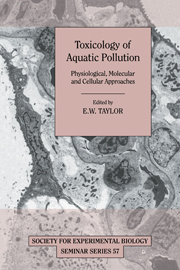Book contents
- Frontmatter
- Contents
- List of contributors
- Preface
- Water chemistry at the gill surfaces of fish and the uptake of xenobiotics
- Bioaccumulation of waterborne 1,2,4,5-tetrachlorobenzene in tissues of rainbow trout
- Dietary exposure to toxic metals in fish
- The physiology and toxicology of zinc in fish
- Lethal and sub-lethal effects of copper upon fish: a role for ammonia toxicity?
- The physiological status of brown trout exposed to aluminium in acidic soft waters
- Physiological and metabolic costs of acclimation to chronic sub-lethal acid and aluminium exposure in rainbow trout
- Physiological effects of nitrite in teleosts and crustaceans
- Metallothioneins in fish: induction and use in environmental monitoring
- Oestrogenic substances in the aquatic environment and their potential impact on animals, particularly fish
- Effect of genetic toxicants in aquatic organisms
- In vitro toxicology of aquatic pollutants: use of cultured fish cells
- Principles governing the use of cytochrome P4501A1 measurement as a pollution monitoring tool in the aquatic environment
- Index
Physiological and metabolic costs of acclimation to chronic sub-lethal acid and aluminium exposure in rainbow trout
Published online by Cambridge University Press: 20 May 2010
- Frontmatter
- Contents
- List of contributors
- Preface
- Water chemistry at the gill surfaces of fish and the uptake of xenobiotics
- Bioaccumulation of waterborne 1,2,4,5-tetrachlorobenzene in tissues of rainbow trout
- Dietary exposure to toxic metals in fish
- The physiology and toxicology of zinc in fish
- Lethal and sub-lethal effects of copper upon fish: a role for ammonia toxicity?
- The physiological status of brown trout exposed to aluminium in acidic soft waters
- Physiological and metabolic costs of acclimation to chronic sub-lethal acid and aluminium exposure in rainbow trout
- Physiological effects of nitrite in teleosts and crustaceans
- Metallothioneins in fish: induction and use in environmental monitoring
- Oestrogenic substances in the aquatic environment and their potential impact on animals, particularly fish
- Effect of genetic toxicants in aquatic organisms
- In vitro toxicology of aquatic pollutants: use of cultured fish cells
- Principles governing the use of cytochrome P4501A1 measurement as a pollution monitoring tool in the aquatic environment
- Index
Summary
Introduction
Chronic exposure of freshwater fish to sub-lethal aluminium concentrations is frequently encountered in low pH soft water owing to the acid-induced leaching of Al from soils and sediments (Wright & Gjessing 1976; Cronan & Schofield, 1979; Dickson, 1980). It is now clear that, at pH values between 4.7 and 5.5, fish kills may be primarily due to the presence of Al rather than the H+ concentration per se (Schofield & Trojnar 1980; Baker & Schofield 1982). Physiological studies have demonstrated that the gills are the primary target organ of acute exposure to both acid or acid combined with sub-lethal Al concentrations (for reviews see Wood, 1989, 1992; Wood & McDonald, 1987). Ionoregulatory toxicity is a key feature of acid exposure (with or without Al present) whereas, under moderately acid conditions (pH levels greater than about 5), sub-lethal Al exposure is compounded by pronounced respiratory toxicity (Neville, 1985; Wood et al., 1988a,c; Walker, Wood & Bergman, 1988; Playle, Goss & Wood, 1989; Witters, Van Puymbroeck & Vanderbrought, 1991). The ionoregulatory and respiratory disturbances are associated with surface binding and precipitation of Al on the gills (Playle & Wood 1989, 1991; Reid, Rhem & McDonald, 1991; see also Brown & Waring, this volume). However, these disturbances are usually acute, limited to an initial ‘shock’ phase lasting 2–5 days, and followed by a slower period of acclimation (the development of increased resistance to Al), repair and various degrees of physiological recovery (McDonald & Wood, 1992). It is now apparent that not all processes can recover fully during chronic acid+Al exposure and that acclimation may bear certain physiological and metabolic costs (Wilson, Bergman & Wood, 1994a,ft; Wilson, Wood & Houlihan, 1995).
- Type
- Chapter
- Information
- Toxicology of Aquatic PollutionPhysiological, Molecular and Cellular Approaches, pp. 143 - 168Publisher: Cambridge University PressPrint publication year: 1996
- 1
- Cited by



